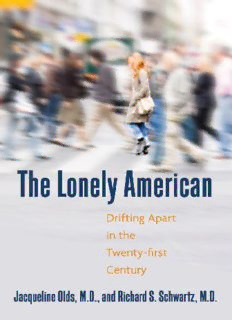
The Lonely American: Drifting Apart in the Twenty-first Century PDF
Preview The Lonely American: Drifting Apart in the Twenty-first Century
The Lonely American The Lonely American Drifting Apart in the Twenty-first Century Jacqueline Olds, M.D., and Richard S. Schwartz, M.D. Beacon Press Boston Beacon Press 25 Beacon Street Boston, Massachusetts 02108-2892 www.beacon.org Beacon Press books are published under the auspices of the Unitarian Universalist Association of Congregations. © 2009 by Jacqueline Olds, M.D., and Richard S. Schwartz, M.D. All rights reserved Printed in the United States of America 12 11 10 09 8 7 6 5 4 3 2 1 This book is printed on acid-free paper that meets the uncoated paper ANSI/NISO specifications for permanence as revised in 1992. Text design by Yvonne Tsang at Wilsted and Taylor Publishing Services Library of Congress Cataloging-in-Publication Data Olds, Jacqueline. The lonely American : drifting apart in the twenty-first century / Jacqueline Olds and Richard S. Schwartz. p. cm. Includes bibliographical references and index. ISBN-13: 978-0-8070-0034-2 (hardcover : alk. paper) 1. Social isolation—United States. 2. Loneliness—United States. I. Schwartz, Richard (Richard S.) II. Title. HM1131.O43 2008 302.5'45097309051—dc22 2008019339 To our parents, our children, and our friends, who have kept us from being lonely Contents CHAPTER 1 The Elephant in the Room 1 CHAPTER 2 Frantic without a Peep: Busyness as a Virtue and a Curse 13 CHAPTER 3 Self-Reliance: Do Lonesome Cowboys Sing the Blues? 33 CHAPTER 4 Left Out: An Organism under Stress 57 CHAPTER 5 Free at Last: American Living Arrangements 79 CHAPTER 6 The Technology of Relationships: A Brief Review 95 CHAPTER 7 Love and Marriage in a Busy World 115 CHAPTER 8 The Ripple Effects of Increasing Social Isolation 135 CHAPTER 9 Social Disconnection and the Mental Health Industry 159 CHAPTER 10 Staying Limber 175 Acknowledgments 195 Notes 197 Index 213 CHAPTER 1 The Elephant in the Room Americans in the twenty-first century devote more technology to staying connected than any society in history, yet somehow the devices fail us: studies show that we feel increasingly alone. Our lives are spent in a tug-of-war between conflicting desires— we want to stay connected, and we want to be free. We lurch back and forth, reaching for both, and are surprised by our sadness when one side actually wins. How much of one should we give up in order to have more of the other? How do we know when we’ve got it right? This argument probably began as soon as language made it possible for groups to argue, but it is also a particularly Ameri- can controversy. Over the last decade, the debate about freedom and connection in the United States has leaped from rarely read doctoral dissertations to front-page national news. What caught people’s attention was a series of alarms, given in the form of data-driven studies, suggesting that our society is in the midst of a dramatic and progressive slide toward disconnection. Robert Putnam’s Bowling Alone was the loudest alarm, combining exten- sive data on the fraying of social connections with a powerful the- sis demonstrating the importance of social networks to a healthy democracy. The book struck a chord and seemingly endless pub- 1
Description: